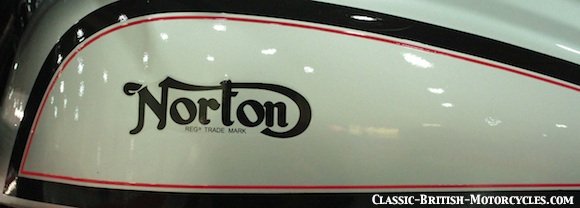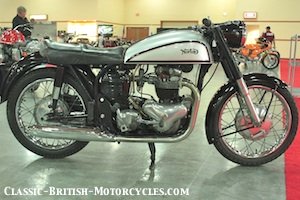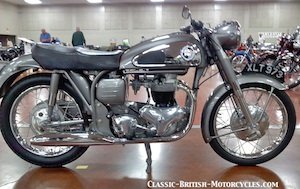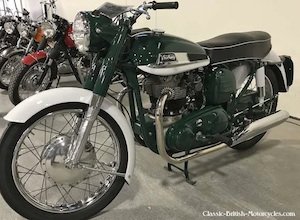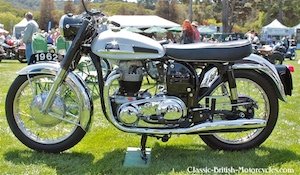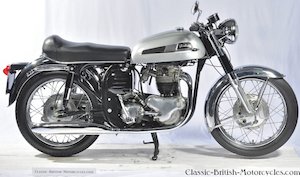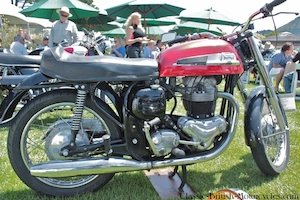CROWDED MARKET
The Norton Dominator was Norton’s entry into the crowded vertical twin market, & it was intended to capitalize on the success of, & hopefully steal some sales from, the trend-setting Triumph Speed Twin. When it was introduced in 1949, the 500cc Dominator Model 7 was a handsome enough machine. The new engine was a non-unit (separate engine, primary & gearbox) vertical twin that generally followed convention for a British motorcycle at the time. It was designed by Bert Hopwood who had worked on the Speed Twin project while working for Triumph Motorcycles.
NEW ENGINE – FRAME COMBO
In fact, when it came to the Dominator’s frame, Norton opted for the same trick that Edward Turner pulled when he created the Speed Twin: Put the new twin engine in the old single frame. However, the single cylinder bike that Norton borrowed the frame from was the ES2, which was essentially a low-volume, hand-built bike. This stuck the new Norton Dominator with a high price relative to the competition & as the result, sales were slow. But, Norton was in the heavy twin business & this engine would be stretched & massaged & kept in service for over a quarter century.
OFF TO A SLOW START
So, Norton’s legacy of twins got off to a bit of a slow start. And on top of that ES2 frame being expensive, it was also primitive, still relying on the archaic ‘plunger’ rear suspension instead of a modern swing arm setup. At least it had long Roadholder telescopic forks with 7-inch brakes. Interestingly, this stone-age frame survived the 1952 introduction of the revolutionary, trend-setting Featherbed frame (with swing arm rear suspension) on the new Dominator 88 until it was replaced on the Dominator Model 7 line in 1953. At the time, it was believed that the Featherbed was unsuitable for sidecar duty, where the old plunger frame was actually preferred. 1954 brought a much-needed 8-inch front brake.
A LEGENDARY RACING FRAME
When the Featherbed finally did arrive, the humble Dominator Model 7 (1949-56) was instantly transformed into a world class road warrior. The Featherbed was indeed one of the finest racing chassis in the world at that time, truly in a class to itself. The fact that the legendary Featherbed trickled down directly from racing to the general public is a textbook example of the lexicon: “Win on Sunday, Sell on Monday”. It certainly worked for Norton Motorcycles & every machine that rolled off the assemblyline with one.
FEATHERBED HITS THE STREETS
The 500 twin engine of the Model 7 in a new Featherbed Frame made such a quantum leap forward that it became a whole new model, the Norton Dominator 88, which ran from 1952-63.
By 1956 the relentless quest for more power led to the first step in a litany of boost in displacement. The Norton Dominator 99 (1956-62) was the 596cc version of the old 500 Model 7. It was called a 600, of course.
THE DOMINATORY FAMILY
The Norton Dominator family of motorcycles soldiered on in two forms, the Dominator 88 & the Dominator 99 until replaced by the new Norton Atlas line in 1962, with some overlap of production into the 1963 model year. The Norton Dominator really started the Norton twin legacy that ended with the legendary Norton Commando, one of the greatest Classic British Motorcycle ever built, a span of over a quarter of a century. Today, Norton motorcycles are among the most prized & sought-after Classic British Motorcycles.
Norton Dominator Model 7 – 1949-1956

The ‘Plunger’-style rear suspension is clearly visible here on this 1951 Norton Dominator Model 7.
While the humble Dominator Model 7 never got the Featherbed Frame, it did receive a new rear frame section with swing arm suspension in 1953, along with a new 19-inch front wheel.
ENGINE
At the heart of the Norton Dominator Model 7 was an engine that was so ‘right’ (by the standard of the day, anyway) that it survived & prospered through 5 different displacements (500, 600, 650, 750 & 850) & 3 major model changes (Dominator, Atlas & Commando) spanning some 27 model years. Toward the end of its life, stretched to its limits & beyond at 828cc (850 Commando), it wasn’t so much that it was still in service because it was such a perfect design, but more a matter of the limited resources the factory had to work with. They simply couldn’t afford a replacement.
BERT HOPWOOD DESIGN
The Bert Hopwood-designed engine follows the standard British vertical twin paradigm of the day, a 497cc vertical twin with 360-degree crank, central flywheel & 2-piece conrods with shell-type plain bearings. One chain-driven camshaft sat high in the crankcase just ahead of the cylinder block. The pushrods passed through a tunnel between the cylinders, operating rocker arms. Early dynamo-equipped bikes had a gear on the cam driving the dynamo which sat in the traditional position, in front of the engine. On early bikes, a magneto living behind the cylinders provided ignition. It was driven by a chain that ran forward to the same intermediate gear that drove the cam chain. All of this was contained behind an attractive “Y” shaped polished alloy timing chest. The fact that Hopwood also worked at BSA could be why the Norton twin bears at least a superficial resemblance to a pre-unit BSA A7/A10 twin.
Norton Dominator 88 – 1952-1963

The Norton Dominator 88 is what you get when you drop a Norton 500cc vertical twin engine from a Dominator Model 7 into a Featherbed Frame. It ended up being the best-handling production motorcycle on Earth & it dominated racing both on the street & the track for the next decade. The Featherbed not only had excellent geometry, gleaned from years of racing experience, they were extremely rigid, allowing none of the chassis flex that was so common to motorcycles of the era. Early swing-arm Triumphs flexed so badly that they became known by the nickname “Whip Iron”. The secret behind the Featherbed’s great strength & light weight was that it was made up mostly of two loops of tubing running unbroken forming the 2 cradles with the ends meeting at the neck. Unusual at the time, the double backbones tied into the bottom of the steering head & the front downtubes passed between them & made their way to the top of the steering head. Race-inspired, it worked great except that it was found the frame would bend at the neck if bumped into a curb, something that never occurred in racing so it wasn’t allowed for. A reinforcing gusset was installed & the problem was solved. They formed the 2 front downtubes, engine cradle, seat post & double backbone. Properly cross-braced it was incredibly light & had a very unusual look to it, compared to other British bikes of the day with conventional single backbones. The rear subframe was bolted at first, then later welded to the mainframe. And most importantly, the crucial area around the swingarm pivot was heavily braced.
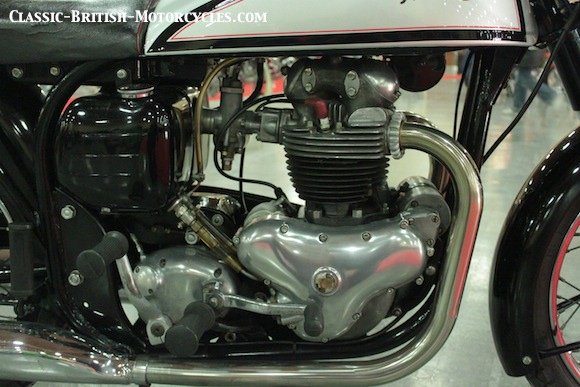
BETTER HANDLING, MUCH BETTER
So, in the end, in theory the Dominator 88 wasn’t any faster than the Model 7 in a straight line. It just handled better…much better…much, much better. I mean, c’mon here, we’re talking about the Featherbed, one of the only motorcycle frames with a name, for crying out loud! The only other ones that spring to mind (“Whip Iron”, “Duplex”) are all remembered for their crapiness.
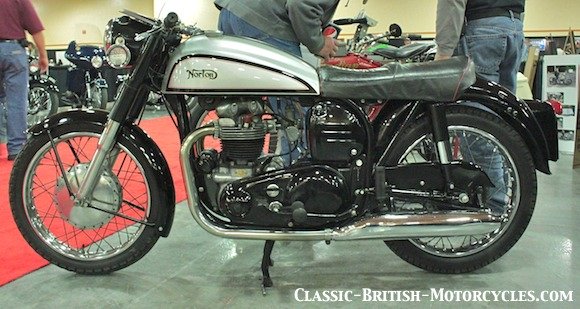
FINALLY REPLACED BY ISOLASTIC
Interestingly, when the Featherbed was finally replaced in 1967 by the revolutionary new Norton Commando frame with patented Isolastic Suspension, the frame’s designer, former Rolls Royce engineer Dr. Stefan Bauer believed the Featherbed’s design was fundamentally unsound. That’s why the Commando frame is so different, with its single, but large-diameter backbone.
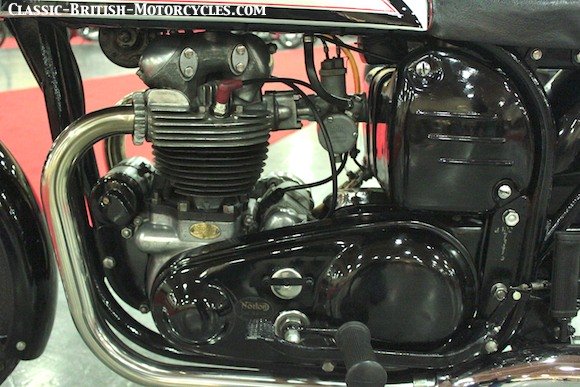
POOR QUALITY CONTROL
But the Norton Dominator 88 was fast, real fast for 1953 (90mph) & had the best brakes in the business to boot. Also known as “the Deluxe”, the 88 had problems with leaky priimary cases & generally poor quality control, demonstrating just how outdate & inefficient Norton’s production methods were. At that time, they were barely pumping out 200 Dominator 88’s a week, so it’s not like they couldn’t keep up with QC.
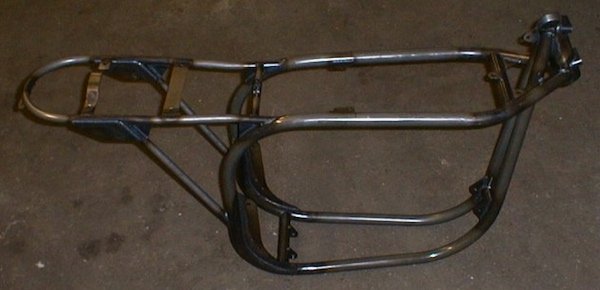
NORTON FEATHERBED FRAME
Norton Featherbed Frame, unpainted. All welded construction was a departure from the standard practice of brazing tubing into cast lugs. Notice how the frame tubes that form the double engine cradle are each made of a single piece of tubing, bent into a near-complete circle. They begin & end at the steering head. This simple design, along with lots of high-strength steel, made for a very rigid, yet very light frame. The geometry had been worked out through years of GP road racing in Europe & England including their stunning win at the 1949 Isle of Man TT with a Featherbed-framed Norton Manx. This frame was so good that people dropped other types of engines in them, such as Triumphs & Vincents.
Norton Dominator 99 – 1956-1962
The Norton Dominator 99 was essentially a 500cc Model 88 punched out to 600cc (596cc to be exact). This combined with a higher compression ratio added up to 31hp.
MORE POWER, SCOTTY!
Norton’s image, thanks largely to the Featherbed frame & wins at the Isle of Man TT, was that of a high-performance motorcycle. The US market, the world’s largest by far & a huge part of Norton’s sales, demanded more & more power. Norton had to comply to compete. They responded with constant bumps in engine displacement & other tweaks to pull more out of the venerable twin. They already had the best frame, they were years ahead of the competition here, they just had to keep massaging the engine to remain competitive.
The Model 99 bridged the gap between the 500cc progenitor and the 650cc Dominator SS, which would soldier on in the Norton Atlas.
Norton Dominator 77 – 1956-1958
The Norton Dominator 77 was introduced in 1956 because of an ongoing belief that the Featherbed Frame was unsuitable for sidecar use. So, the Dominator 77 used a swing-arm version of the old brazed-lug ES2 frame & the 596cc (600) twin engine from the Dominator 99.
SIDECARS OK
By 1957 it was clear that the Featherbed could handle sidecars & certain modifications were made to facilitate it. So the need for the Model 77 was now eliminated & it went out of production by 1958.
Norton Dominator 650SS – 1962-1969
NORTON DOMINATOR 650SS, 1962-69
In 1962 the Norton Dominator 650SS was the hot ticket. The Featherbed frame was narrowed along the top rails creating what would be called a “Slimline Featherbed”. The engine displacement was increased again to 650cc and a special twin carb head was installed resulting in a top speed in excess of 110mph. The ‘SS’ stood for Sport Special.
Once they started building 650s, there didn’t seem to be much point to continuing to produce 600s. So 600 production was dropped to concentrate on the new 650.
Norton Dominator YEAR-BY-YEAR
1962 DOMINATOR 88
Norton’s entry-level 500 twin. The Model 7’s engine in a Featherbed frame.
Check out these NORTON BOOKS
Norton Motorcycles: From 1950 to 1986 (British Motor cycles since 1950)
Norton Commando: The Complete Story (Crowood Motoclassic Series)
The Norton Commando Bible: All models 1968 to 1978
The Illustrated History of Norton Motorcycles (English and Spanish Edition)
Norton (Osprey Collector’s Library)
Norton Dominator Performance Portfolio 1949-1970
Norton: The Complete History (Crowood MotoClassics)
For more like this, please visit our
 |
PLEASE BUY MY NEW E-BOOK HERE Click here to buy now: |
Comprehensive Vintage Motorcycle Price Guide 2020-2021


